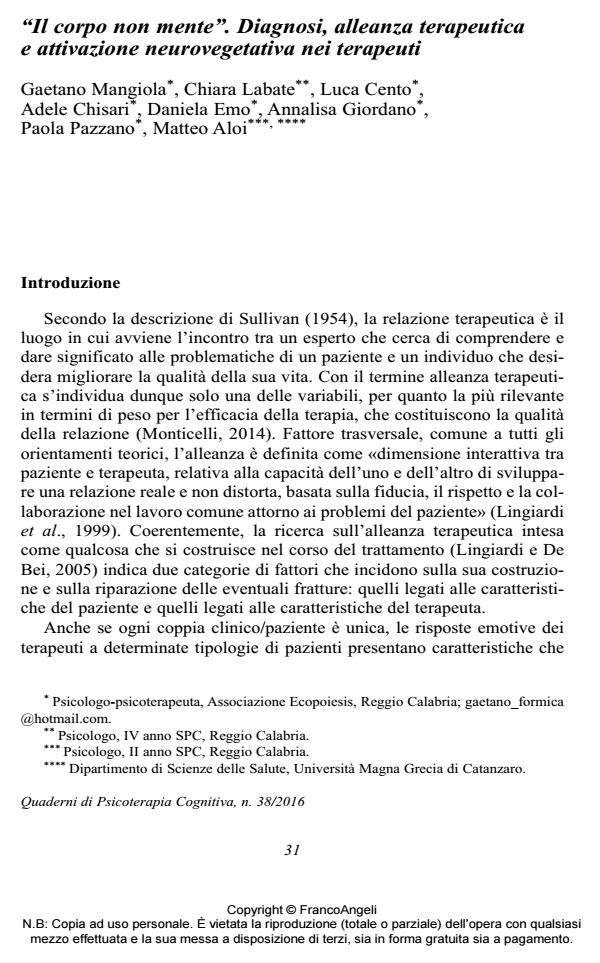"The body doesn’t lie". Diagnosis, therapeutic alliance and neurovegetative activation in the therapists
Journal title QUADERNI DI PSICOTERAPIA COGNITIVA
Author/s Gaetano Mangiola, Chiara Labate, Luca Cento, Adele Chisari, Daniela Emo, Annalisa Giordano, Paola Pazzano, Matteo Aloi
Publishing Year 2016 Issue 2016/38
Language Italian Pages 11 P. 31-41 File size 118 KB
DOI 10.3280/QPC2016-038003
DOI is like a bar code for intellectual property: to have more infomation
click here
Below, you can see the article first page
If you want to buy this article in PDF format, you can do it, following the instructions to buy download credits

FrancoAngeli is member of Publishers International Linking Association, Inc (PILA), a not-for-profit association which run the CrossRef service enabling links to and from online scholarly content.
Different authors agree in recognizing that one of the most influential indicators of a patient’s mental state is the therapist’s experience of her patient. The most influential indicator to measure in this sense is the physical component characterizing the mental state, which is also a powerful means of non-verbal communication. For this reason, the body can be used to read and modulate cognitive and affective components (Semerari, 1999). The aim of this explorative study is to investigate if there is a correlation between the diagnosis, the therapist’s physical activation during the session and the quality of the therapeutic alliance. Five expert therapists (members of the Clinical Center of Cognitive Therapy "Ecopoiesis" in Reggio Calabria) monitored their physical index (pulse, pressure, breathing and muscle tension) for four consecutive weeks, before and after each session of therapy with 67 patients having different diagnoses. The quality of the therapeutic alliance was measured with the Scale To Assess Therapeutic Relationships (STAR) in the patient and clinician version. The hypothesis is that, just as it happens for the emotional reaction (Betan et al., 2005; Colli et al., 2014), patients with similar diagnoses trigger a similar neurovegetative reaction in therapists with a relapse on alliance assessment. Contrary to all expectations, the data collected suggests that there is a relation between the quality of the alliance and the activation of the therapist, but it is not correlated with the diagnosis.
Keywords: Therapeutic alliance, neurovegetative activation, diagnosis
Gaetano Mangiola, Chiara Labate, Luca Cento, Adele Chisari, Daniela Emo, Annalisa Giordano, Paola Pazzano, Matteo Aloi, "Il corpo non mente". Diagnosi, alleanza terapeutica e attivazione neurovegetativa nei terapeuti in "QUADERNI DI PSICOTERAPIA COGNITIVA" 38/2016, pp 31-41, DOI: 10.3280/QPC2016-038003